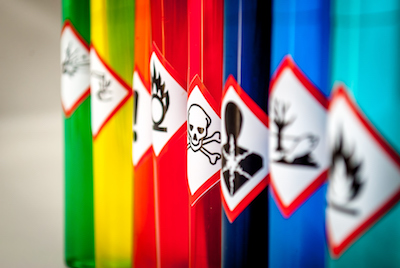EPA Lists 20 Chemicals for High Priority, Comments
WEDNESDAY, AUGUST 28, 2019
The U.S. Environmental Protection Agency announced late last week that it is moving forward with a proposed list of 20 chemical substances to designate as “High-Priority Substances” under the Toxic Substances Control Act.
The EPA made this announcement on the heels of designating 20 other chemicals at low priority.
Some Background
In 2016 the TSCA got its first upgrade in 40 years as part of the Frank R. Lautenberg Chemical Safety for the 21st Century Act, which now requires the EPA to test all of the chemicals that had gotten through the previously weak TSCA (about 85,000 untested chemicals) with a target of about 2,000 a year.
Chemicals are sorted into “high” and “low” priority categories. No further action is taken with chemicals considered to be “low priority,” but “high priority” chemicals then move on to a risk evaluation.

 |
| © iStock / Skyhobo |
|
The U.S. Environmental Protection Agency announced late last week that it is moving forward with a proposed list of 20 chemical substances to designate as “High-Priority Substances” under the Toxic Substances Control Act. |
The risk evaluation first looks at all possible uses of a chemical (everything from how it’s manufactured to how it’s used and how it’s disposed of). Then, it will look at how many possible ways it can come into contact with people and the impact it will have. After its possible exposure is totaled, the EPA will then look at the impact it will have on society’s most vulnerable—such as children—industry workers or the environment. This step has to be concluded within three years. If the EPA thinks it needs more time for analysis, it can extend the process one additional year.
After the evaluation is complete, the EPA decides whether or not to regulate the chemical. If the chemical is deemed unsafe, the EPA then has two years to specify restrictions. This timeframe can also extend an additional year.
In December 2016, the EPA designated the first 10 substances up for evaluation, which included substances such as Methylene Chloride, N-Methylpyrolidone, and Pigment Violet 29.
In March of this year, the EPA issued a final rule to prohibit the manufacture and importing, processing and distribution of methylene chloride in all paint removers for consumer use. And, in June, the EPA held a meeting to discuss Pigment Violet 29 to get the independent review of the science underlying the PV29 risk assessment, including the hazard assessment, assessment of dose-response, exposure assessment and risk characterization.
Earlier this month, the EPA designated 20 substances as “low priority.” To support that designation, the EPA considered reasonably available information for each chemical substance under its conditions of use against the criteria specified in TSCA section 6(b)(1)(A), the organization notes.
Again, a final designation of “low priority” means that a risk evaluation is not warranted at this time.
Those 20 substances designated low priority are:
- 1-Butanol, 3-methoxy-, 1-acetate;
- D-gluco-Heptonic acid, sodium salt (1:1), (2.xi.)-;
- D-Gluconic acid;
- D-Gluconic acid, calcium salt (2:1);
- D-Gluconic acid, .delta.-lactone;
- D-Gluconic acid, potassium salt (1:1);
- D-Gluconic acid, sodium salt (1:1);
- Decanedioic acid, 1,10-dibutyl ester;
- 1-Docosanol;
- 1-Eicosanol;
- 1,2-Hexanediol;
- 1-Octadecanol;
- Propanol, [2-(2-butoxymethylethoxy)methylethoxy]-;
- Propanedioic acid, 1,3-diethyl ester;
- Propanedioic acid, 1,3-dimethyl ester;
- Propanol, 1(or 2)-(2-methoxymethylethoxy)-, acetate;
- Propanol, [(1-methyl-1,2-ethanediyl)bis(oxy)]bis-;
- 2-Propanol, 1,1'-oxybis-;
- Propanol, oxybis-; and
- Tetracosane, 2,6,10,15,19,23-hexamethyl-.
High-Priority List
The EPA has issued documents for each substance—which was initially flagged as high priority in March—that describes chemical-specific information, analysis and basis that the EPA used to support the proposed designation.
 |
| © iStock.com / Antoine2K |
|
The EPA has issued documents for each substance—which was initially flagged as high-priority in March—that describes chemical-specific information, analysis and basis that the EPA used to support the proposed designation. |
The agency is asking stakeholders and the public to submit comments by Nov. 21.
“By proposing to prioritize 20 chemicals for risk evaluation, EPA is realizing another one of the key requirements of the Frank R. Lautenberg Chemical Safety for the 21st Century Act,” said Assistant Administrator for EPA’s Office of Chemical Safety and Pollution Prevention Alexandra Dapolito Dunn in a press release.
“Taking public comment will help advance our understanding about how these chemicals are used in commerce and brings EPA one step closer to completing the prioritization process.”
The EPA is required to make final designations for these 20 substances by December, and that finalization starts the three-year risk evaluation process.
The 20 proposed high-priority chemicals include seven chlorinated solvents, six phthalates, four flame retardants, formaldehyde, a fragrance additive and a polymer precursor.
The full list includes:
- p-Dichlorobenzene;
- 1,2-Dichloroethane;
- trans-1,2- Dichloroethylene;
- o-Dichlorobenzene;
- 1,1,2-Trichloroethane;
- 1,2-Dichloropropane;
- 1,1-Dichloroethane;
- Dibutyl phthalate (DBP) (1,2-Benzene- dicarboxylic acid, 1,2- dibutyl ester);
- Butyl benzyl phthalate (BBP) - 1,2-Benzene- dicarboxylic acid, 1- butyl 2(phenylmethyl) ester;
- Di-ethylhexyl phthalate (DEHP) - (1,2-Benzene- dicarboxylic acid, 1,2- bis(2-ethylhexyl) ester);
- Di-isobutyl phthalate (DIBP) - (1,2-Benzene- dicarboxylic acid, 1,2- bis-(2methylpropyl) ester);
- Dicyclohexyl phthalate;
- 4,4'-(1-Methylethylidene)bis[2, 6-dibromophenol] (TBBPA);
- Tris(2-chloroethyl) phosphate (TCEP);
- Phosphoric acid, triphenyl ester (TPP);
- Ethylene dibromide;
- 1,3-Butadiene;
- 1,3,4,6,7,8-Hexahydro-4,6,6,7,8,8-hexamethylcyclopenta [g]-2-benzopyran (HHCB);
- Formaldehyde; and
- Phthalic anhydride.
Tagged categories: Coating chemistry; Coating Materials; Construction chemicals; EPA; EPA; Health and safety; Regulations; Safety









